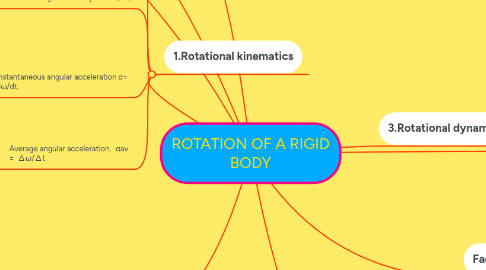
1. The rate of change of angular displacement
2. Average angular velocity,ωav= ∆θ/∆t,
2.1. Angular displacement,θ= s/r
2.1.1. An angle through which a point or line has been rotated in a specified direction in a specified axis.
3. Relationship between linear velocity, v and angular velocity,ω is v=rω
4. 1.Rotational kinematics
4.1. unit in radian (rad)
4.2. Instantaneous angular velocity ω= dθ/dt,
4.2.1. Instantaneous rate of change of angular displacement
4.2.2. vector quantity
4.2.3. radian per second
4.3. Instantaneous angular acceleration α= dω/dt,
4.3.1. The instantaneous rate of change of angular acceleration
4.3.2. vector quantity
4.3.3. radian per second per second
4.4. Average angular acceleration, αav = ∆ω/∆t
4.4.1. The rate of change of the angular velocity
4.4.2. radian per second per second
5. 4.Conservation of angular momentum
5.1. Angular momentum, L=Iω
5.1.1. The product of angular velocity of the body and its moment of inertia about the rotation axis.
5.1.2. vector quantity
5.1.3. unit- kilogram metre square per second
5.2. Relationship between angular momentum, L and linear momentum, p
5.2.1. A vector sums of all the torque acting on a rigid body ism proportional to the rate of change of the angular momentum
5.3. Relationship between angular momentum, L and linear momentum, p
5.3.1. Iω=constant if Στ ⃗ = 0
6. Στ=Iα
7. Factors that affect I
7.1. mass of the body
7.2. shape of the body
7.3. position of the rotation axis
8. 3.Rotational dynamics
8.1. Moment of inertia,I = ∑_(i=1)^n▒m_(i r^2 )
8.1.1. The sum of the products of the mass of each particle and the square and its respective distance from the rotation axis.m
8.1.2. scalar quantity
8.1.3. unit- kilogram metre square
9. 2.Equilibrium of a uniform rigid body
9.1. Torque,τ ⃗ = r ⃗ × F ⃗
9.1.1. The product of a force and its perpendicular distance from the line of action of the force to the point (rotation axis)m
9.1.2. Rigid body,ΣF ⃗ =F_(nett )= 0
9.1.2.1. A body with definite shape that doesn’t change so that the particles that compose it stay in fixed position relative to one another even though a force is exert on it.
9.1.3. Centre of gravity, CG = the point at which the whole weight of the body may be considered to act

